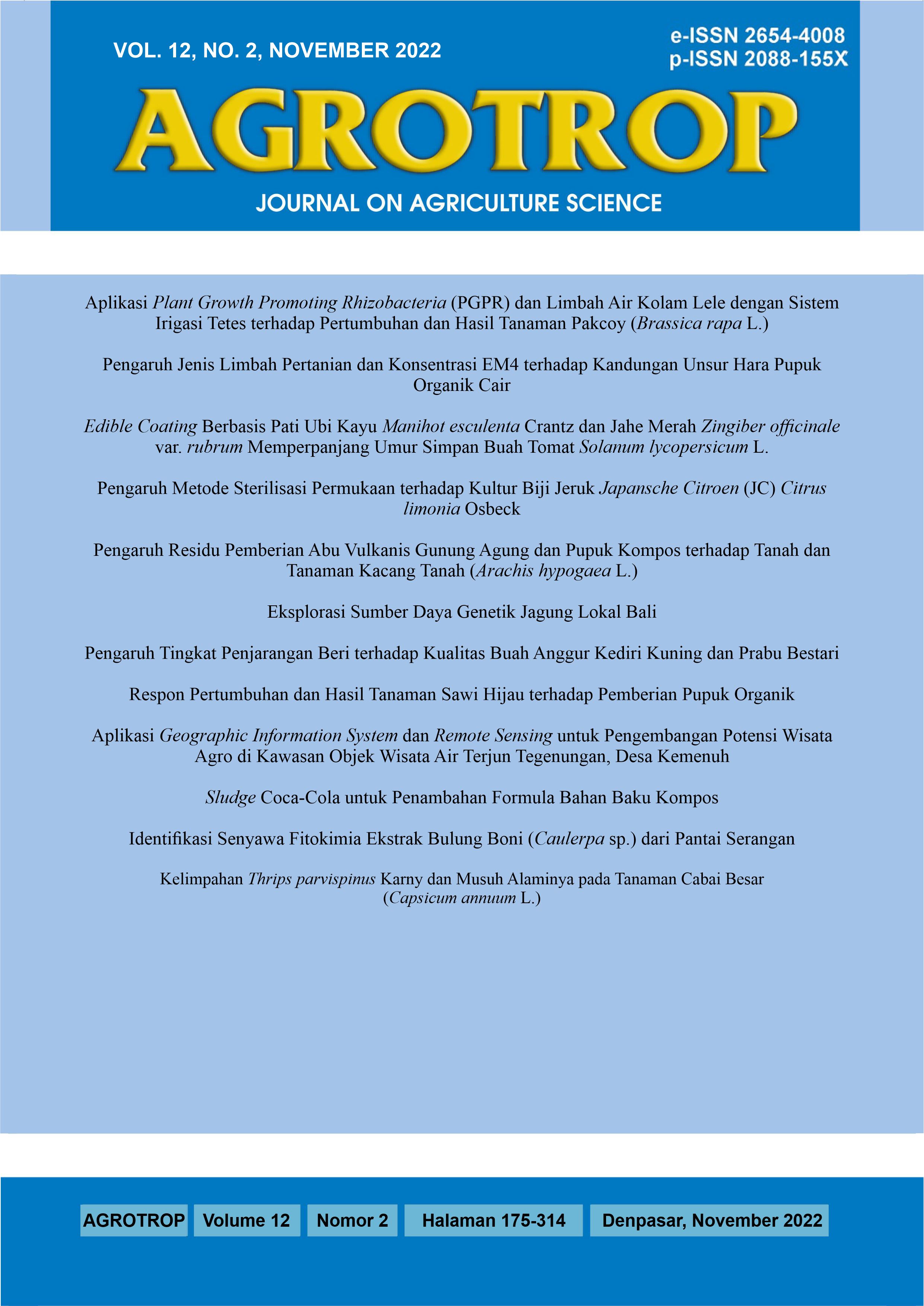Edible Coating Berbasis Pati Ubi Kayu Manihot esculenta Crantz dan Jahe Merah Zingiber officinale var. rubrum Memperpanjang Umur Simpan Buah Tomat Solanum lycopersicum L.
Abstract
Edible Coating based on Cassava Starch Manihot esculenta Crantz and Red Ginger Zingiber officinale var. rubrum Extends Shelf Life of Tomato Fruit Solanu lycopersicum L. Packaging with edible coating is one of the efforts developed to overcome soft rot in fruit, especially cut fruit such as tomatoes, Solanum lycopersicum L. This study aims to test natural preservatives for cut fruit through edible coatings with the addition of active compounds that have antioxidants and antifungals that can extend the shelf life of tomatoes. The method used for coating is starch-based edible coating with the addition of red ginger extract Zingiber officinale var. rubrum. Rhizoma as a bioactive compound that has antimicrobial and antioxidant properties. Soaking the samples using the edible coating method with distilled water, 0.4% CMC (carboxy methyl cellulose) solution and 5% glycerol, 4% cassava starch, and 0.1% red ginger extract. The treatments consisted of control (without treatment), coating with cassava starch-based edible coating, and edible coating with the addition of red ginger extract and storage time (3, 6 and 9 days). During the storage period, weight loss and texture tests were carried out. The results of the edible coating test with the addition of ginger extract are fungicidal against the fungus Aspergillus niger, had strong antioxidant properties with an IC50 value of 82.55 ppm and had the lowest weight loss in the edible coating treatment with the addition of ginger extract of 3.58% on day 9. The best texture in the edible coating treatment with the addition of ginger extract was 1.87 N on the 9th day . These results showed that edible coating based on cassava starch with the addition of 0.1% ginger extract was able to increase the shelf life of tomato Solanum lycopersicum L. for 9 days at room temperature.
Downloads
References
Bastos W. R., Rossato L., Goldman G.H., and Santos D.A. 2021. Fungicide effects on human fungal pathogens: Cross-resistance to medical drugs and beyond. PLoS Pathogens. 17(12): e1010073. doi: 10.1371/journal.ppat.1010073.
da Silva Rios, A.D., Nakamoto, M.M., Cavalcante, A.R., Cunha, B.E.M., and da Silva. 2022. Food coating using vegetable sources: importance and industrial potential, gaps of knowledge, current application, and future trends. Applied Food Research. 2(1): 100073. https://doi.org/10.1016/j.afres.2022.100073.
Duguma, T. H. 2021. Potential application and limitation of edible coatings for maintaining tomato quality and shelf life. International Journal of Food Science & Technology. DOI:10.1111/ijfs.15407.
Eboibi Okeoghene and Hilary Uguru. 2017. Storage conditions effect on physical, mechanical and textural properties of intact cucumber (cv Nandini) Fruit. International Journal of Engineering and Technical Research (IJETR). 7(11).
Elsa-Montes, D and Castro-Muñoz, R. 2021. Edible films and coatings as food-quality preservers: an overview. J. Foods. 10(2): 249. doi: 10.3390/foods10020249.
Embuscado Milda, 2019. Bioactives from culinary spices and herbs: a review. Journal of Food Bioactives. 6. doi:10.31665/JFB.2019.6186.
Gundari Suci, Budhi Surastri and Helmia Farida. 2017. Perbandingan efektivitas ekstrak jahe merah (Zingiber officinale var. rubrum) dengan ketokonazol 2% secara in vitro. Jurnal Kedokteran Diponegoro. 6(2).
Herrick J.E and Hashmi M.F. 2022. Antifungal ergosterol synthesis inhibitors. National Library of Medicine. National center for Biotechnology information.
Isopencu, O.G., et al. 2021. Development of antioxidant and antimicrobial edible coatings incorporating bacterial cellulose, pectin, and blackberry pomace. Carbohydrate Polymer Technologies and Applications. 2. 100057. https://doi.org/10.1016/j.carpta.2021.100057.
J. Cruz et al., 2020. Phytochemical constituents, antioxidant, cytotoxic,and antimicrobial activities of the ethanolic extract of mexican brown propolis. J. Antioxidants. 9(70). doi:10.3390/antiox9010070.
Johan S et al., 2020. Antioxidant activity screening of seven Indonesian herbal extract. Biodiversitas. 21(5): 2062-2067. DOI: 10.13057/biodiv/d210532.
Lima, A. M. S., da Conceição, M., de Oliveira, F., Pimenta, A., and Uchôa, P.K.S., 2019. Aspergillus niger: a hundred years of contribution to the natural products chemistry. Journal of the Brazilian Chemical Society. 30(10). DOI:10.21577/0103-5053.20190080.
Lysenko R.B.C et al. 2019. The starch is (not) just another brick in the wall: the primary metabolism of sugars during banana ripening. Front. Plant Sci., Sec. Plant Metabolism and Chemodiversity. https://doi.org/10.3389/fpls.2019.00391.
Manoj, K., et al., 2022. Valorization potential of tomato (Solanum lycopersicum L.) seed: nutraceutical quality, food properties, safety aspects, and application as a health-promoting ingredient in foods. J. Horticulturae. 8(3): 265 https://doi.org/10.3390/horticulturae8030265.
Mao, Qet al., 2019. Bioactive compounds and bioactivities of ginger (Zingiber officinale Roscoe). Foods. 8(6): 185. doi: 10.3390/foods8060185.
Michelle, M. 2022. Storage for methanolic seed extract. J. Science Topic.
Miele A.N., Volpe S., Torrieri E., and Cavella S. 2022. Improving physical properties of sodium caseinate based coating with the optimal formulation: effect on strawberries’ respiration and transpiration rates. Journal of Food Engineering. 331: 111123. https://doi.org/10.1016/j.jfoodeng.2022.111123.
Mishra B., B. S. Khatkar, M.K. Garg, and Lester A Wilson., 2014. Permeability of edible coatings. Journal of Food Science and Technology. 47(1):109-13 DOI:10.1007/s13197-010-0003-7.
Nasreddine, B., Debeaufor, F., and Karbowiak, T. 2018. Bioactive edible films for food applications: mechanisms of antimicrobial and antioxidant activity. J. Critical Reviews in Food Science and Nutrition. 59(3):1-79. DOI:10.1080/10408398.2018.1494132.
Oluwadara, A., Adedokun, O., Odeyemi, Strateva, M., and Stratev., D. 2022. Microbial spoilage of vegetables, fruits and cereals. J. Applied Food Research. 2(1): 100122. https://doi.org/10.1016/j.afres.2022.100122.
Rizki, N., Andayani, Y., and Hakim, A. 2020. Antioxidant activity of fruit extract powder beans (Phaseolus vulgaris L.) using dpph method. Journal of Research in Science Education. 6(2). DOI: 10.29303/jppipa.v6i2.409.
Rodríguez, C. M., Camilo, Yépez, V., Humberto, J., González, G., Ortega-Toro, R. 2020. Effect of a multifunctional edible coating based on cassava starch on the shelf life of andean blackberry. Heliyon. 6(5). https://doi.org/10.1016/j.heliyon.2020.e03974.
Salwa S et al., 2022. Development of edible coating from gelatin composites with the addition of black tea extract (Camellia sinensis) on minimally processed watermelon (Citrullus lanatus). Polymers. 14: 2628. https://doi.org/10.3390/polym14132628.
Simran S., Cheng S.F., Bhattacharya B., and Chakkaravarthi S. 2019. Efficacy of free and encapsulated natural antioxidants in oxidative stability of edible oil: special emphasis on nanoemulsion-based encapsulation. Trends in Food Science & Technology. 91. DOI:10.1016/j.tifs.2019.07.030.
Strano C.M et al.,2022. Postharvest technologies of fresh citrus fruit: advances and recent developments for the loss reduction during handling and storage. Horticulturae. 8(612). https://doi.org/10.3390/horticulturae8070612.
Tianyu, J., et al., 2020. Starch-based biodegradable materials: challenges and opportunities. Advanced Industrial and Engineering Polymer Research. 3(1): 8-18. https://doi.org/10.1016/j.aiepr.2019.11.003.
Weida Z et al., 2022 . The role of cell wall polysaccharides disassembly and enzyme activity changes in the softening process of hami melon (Cucumis melo L.). Foods. 11(6): 841. doi: 10.3390/foods11060841.
Wenzhong H., Sarengaowa and Ke Feng. 2022. Effect of edible coating on the quality and antioxidant enzymatic activity of postharvest sweet cherry (Prunus avium L.) during storage. Coatings. 12(581). https://doi.org/10.3390/coatings12050581.
Wirongrong T et al. 2020. Physical and antioxidant properties of cassava starch–carboxymethyl cellulose incorporated with quercetin and tbhq as active food packaging. Polymers. 12(2): 366. https://doi.org/10.3390/polym12020366.
Yong Yang, et al. 2016. Different expression analysis in fruit softening and ethylene biosynthetic pathways in peaches of different flesh textures. Horticultural Plant Journal. 2(2): 75-81. https://doi.org/10.1016/j.hpj.2016.06.006.











